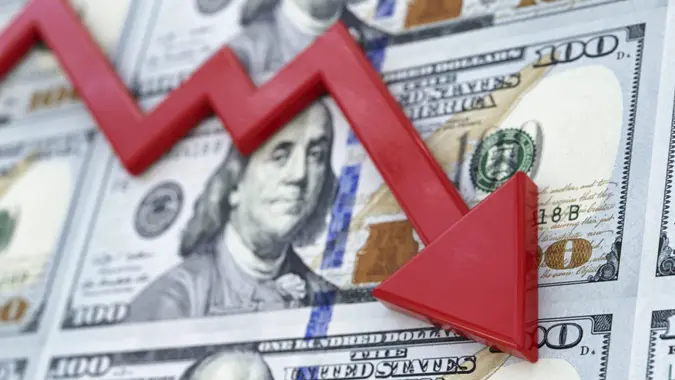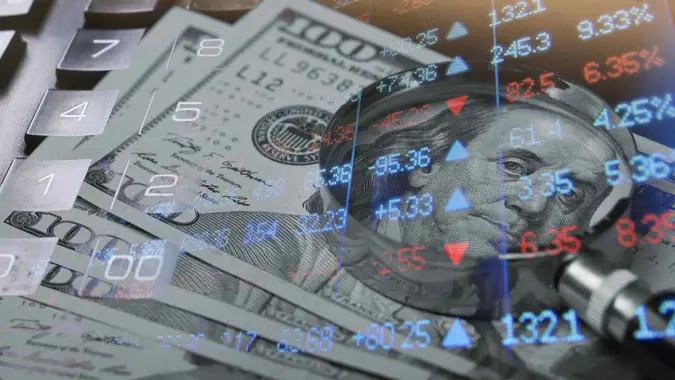What Moody’s Downgrade of the US Credit Rating Means for Investors

Commitment to Our Readers
GOBankingRates' editorial team is committed to bringing you unbiased reviews and information. We use data-driven methodologies to evaluate financial products and services - our reviews and ratings are not influenced by advertisers. You can read more about our editorial guidelines and our products and services review methodology.

20 Years
Helping You Live Richer

Reviewed
by Experts

Trusted by
Millions of Readers
Moody’s Ratings became the third and final credit rating to downgrade the U.S. government’s debt from its top rating by one notch from Aaa to Aa1.
Read More: 12 Best Safe Investments To Grow Your Money in 2025
Find Out: 4 Low-Risk Ways To Build Your Savings in 2025
According to a statement released on May 16 by Moody’s Ratings, the downgrade “reflects the increase over more than a decade in government debt and interest payment ratios to levels that are significantly higher than similarly rated sovereigns.”
While there has been considerable speculation about the potential impact of the downgrade on the overall economy, GOBankingRates consulted with experts to determine its likely effect on investors as the year unfolds in 2025.
Borrowing Money Will Be Expensive
“Moody’s downgrade of the U.S. credit rating from Aaa to Aa1 will directly increase borrowing costs for American consumers,” said David Johnson, a financial expert and CEO of Vervent. A CNBC article also shared that the downgrade could lead to higher interest rates on consumer loans, making the cost of borrowing money more expensive.
This is the first time all three major rating agencies have downgraded U.S. debt, mainly due to the rising debt levels and interest payment obligations. Johnson pointed out that treasury yields immediately spiked, with the 30-year bond hitting 5%, indicating higher rates ahead for credit cards, auto loans, and mortgages. This would impact Americans seeking new credit or carrying any variable-rate debt. If mortgage rates increase, then potential homebuyers may think twice about entering the market,
This leads us to the next point.
Discover Next: How To Turn $100K Into a Million: Your Step-by-Step Guide
Higher Borrowing Costs Could Impact Consumer Spending
Higher interest rates on consumer loans would hurt those who are already struggling with debt, and it would likely eliminate the hope of any relief in the near future. According to recent data from Experian, the average credit card balance for U.S. consumers reached $6,730 in the third quarter of 2024, which was a 3.5% increase from the previous year. It’s also worth noting that the total amount of consumer credit card debt for American consumers increased by 8.6% on an annual basis in the same quarter, reaching $1.16 trillion.
This impacts investors in two ways:
- Investors could be less likely to take on risks. Someone looking to invest capital into a business or get into any kind of real estate could think twice about getting involved with the rising costs of borrowing money.
- Consumers may prioritize saving money or paying down debt. When consumers prioritize saving over spending, it leads to companies reporting lower-than-expected earnings.
The harsh reality is that higher interest rates may force consumers to prioritize paying down high-interest debt and to delay spending as they focus on managing their finances. With consumer spending declining and lower earnings, layoffs could occur, potentially tipping the economy into a recession. This would all impact investors because it could lead to stock prices dropping and companies cutting dividends.
Investor Confidence Will Be Tested
“The U.S debt level has been and continues to be a concern going forward, and while this downgrade isn’t a surprise, its timing is likely to attract investor attention,” said Chris Fasciano, the chief market strategist at Commonwealth Financial Network. He also mentioned that Congress is currently negotiating a budget deal, which includes a tax cut plan that could further increase the deficit.
Fasciano noted that this isn’t a new issue for investors and that investors have long believed that the U.S. can address its fiscal situation when necessary. “If that confidence remains in place, it is unlikely the U.S. is headed for a ‘Truss’ moment like the U.K. experienced in 2022 around its government fiscal policies,” he said.
Fasciano shared a brief history of the impact of downgrades from credit agencies:
- S&P Global Ratings was the first agency to downgrade the U.S. in August 2011. The S&P 500 fell 6.6% the day after the announcement, but by the end of the week, it rallied back to close down just 1.7 percent.
- In August 2023, when Fitch did the same, the markets declined only 0.7% on the first day.
There’s a Possibility of Weakened Investor Confidence
David Capablanca, a trading expert and host of The Friendly Bear Podcast, noted that U.S. Treasury bonds have long been considered the safest asset in the world. He believes that a downgrade can lead to a decline in investor confidence, both domestically and internationally. “Investors may become more hesitant to hold US assets, potentially triggering capital flight, making it more difficult for the government to finance its debt,” said Capablanca.
While there are no signs indicating that this will happen anytime soon, you never know how consumers and businesses will respond to higher interest rates and the potential consequences for the overall economy.
Fasciano concluded, “We don’t anticipate a long-term impact on markets from Moody’s actions, but it does further shine a spotlight on an issue that we have been hearing more about from our advisors. Deficit funding is a risk going forward and is another reason we believe diversification across geographies is the best way to navigate the uncertainty in the U.S.”
 Written by
Written by  Edited by
Edited by 

























